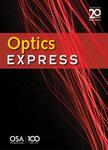版权所有:内蒙古大学图书馆 技术提供:维普资讯• 智图
内蒙古自治区呼和浩特市赛罕区大学西街235号 邮编: 010021

作者机构:Univ Waterloo Dept Syst Design Engn Waterloo ON N2L 3G1 Canada Univ Waterloo Dept Phys & Astron Waterloo ON N2L 3G1 Canada
出 版 物:《OPTICS EXPRESS》 (Opt. Express)
年 卷 期:2010年第18卷第8期
页 面:8338-8352页
核心收录:
学科分类:070207[理学-光学] 07[理学] 08[工学] 0803[工学-光学工程] 0702[理学-物理学]
基 金:NSERC OCE University of Waterloo
主 题:Image processing algorithms Image quality Speckle noise Speckle patterns Speckle reduction Synthetic aperture radar
摘 要:An important image post-processing step for optical coherence tomography (OCT) images is speckle noise reduction. Noise in OCT images is multiplicative in nature and is difficult to suppress due to the fact that in addition the noise component, OCT speckle also carries structural information about the imaged object. To address this issue, a novel speckle noise reduction algorithm was developed. The algorithm projects the imaging data into the logarithmic space and a general Bayesian least squares estimate of the noise-free data is found using a conditional posterior sampling approach. The proposed algorithm was tested on a number of rodent (rat) retina images acquired in-vivo with an ultrahigh resolution OCT system. The performance of the algorithm was compared to that of the state-of-the-art algorithms currently available for speckle denoising, such as the adaptive median, maximum a posteriori (MAP) estimation, linear least squares estimation, anisotropic diffusion and wavelet-domain filtering methods. Experimental results show that the proposed approach is capable of achieving state-of-the-art performance when compared to the other tested methods in terms of signal-to-noise ratio (SNR), contrast-to-noise ratio (CNR), edge preservation, and equivalent number of looks (ENL) measures. Visual comparisons also show that the proposed approach provides effective speckle noise suppression while preserving the sharpness and improving the visibility of morphological details, such as tiny capillaries and thin layers in the rat retina OCT images. (C) 2010 Optical Society of America